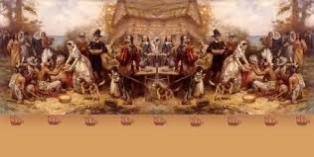Enter to win a copy of the children’s book Cowboy True’s Christmas Adventure.
There was no recorded menu for this most famous of all American dinners. Pilgrim Edward Winslow recorded in detail in his journal the types of foods present, but not how they were cooked and served in which order. Indeed, few of us today would recognize the Pilgrim’s original meal as a traditional Thanksgiving dinner. While turkey was on the table, it was not quite the commanding centerpiece we know today. Lobsters, venison, waterfowl, small game, cod, clams and oysters were more plentiful and better suited for feeding a large crowd. Stuffing birds with specially prepared breading was practiced in Europe from Medieval days forward.
There was no apple pie, fine white bread, or creamed pearl onions. Why? Old world fruits, vegetables, and grains needed to planted and mature. Our Pilgrim mothers substituted squash, maize meal, corn, beans, and local berries out of necessity rather than culinary intrigue. Mashed potatoes? Technically possible but socially unlikely. These New World tubers were transported to North America via Europe. In the Pilgrim’s era potatoes were regarded as barely suitable for animals. It was not until the great famines of the 18th century that potatoes were consumed by humans on a regular basis. Recipes proliferated. Mashed potatoes, enriched with butter and cream became the staple of the laboring classes.
If there is one true thread in this culinary web it may be the American cranberry. This tart, versatile gift provided balance to meat (a la pork and applesauce, ham and pineapple), filling for pie and flavor for cakes. It also, unbeknownst to the Pilgrims, much needed Vitamin C. Nuts also played a special role, as they were associated from ancient times forward with long life, prosperity, and sharing one’s bounty. When dinner was finished, the first Thanksgiving peacefully retreated into the pages of history.
To learn more about how Cowboy True celebrated the holidays read
Cowboy True’s Christmas Adventure.
All proceeds raised from the sale of the book go to benefit UC Davis Children’s Hospital.


